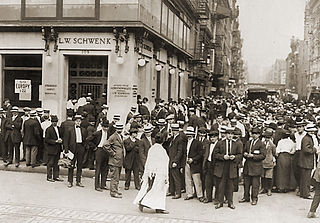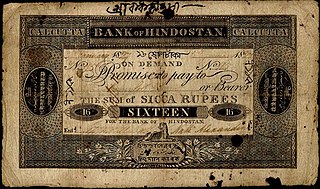| Type | Agency House |
|---|---|
| Founded | 18th century in British India |
| Founders | Scottish traders and merchants |
| Headquarters | Fort William, India, Calcutta, , |
Area served | British India |
| Services | Trading and Banking |
Alexander and Company, Limited, often simply called Alexander and Co., was an Agency House in British India founded by traders and merchants from Scotland. Alexander and Co. has made several pioneering contributions to the economy of India. Alexander and Co. was the promoter and founder of India's very first bank, the Bank of Hindostan. [1]
Before the advent of joint-stock banking companies in India, the role of banks was played by agency houses. The agency houses performed various quasi-banking functions which included but were not limited to: [2]
After their initial success, the agency houses started lending money to European entrepreneurs in India and not just the Government. The Alexander and Co. agency house also lent money to several European entrepreneurs, the most notable among them was Josiah Marshall Heath, an English metallurgist who owned several mining ventures in British India. [3]
An amount of Rupees 100,000 had been loaned to Josiah Marshall Heath by the Alexander and Co. agency house in order to finance his mining related ventures. He used the sum to start the Porto Novo Steel and Iron Company. By 1832, he was unable to repay the debt, and this contributed to the failure of the Alexander and Co. agency house. [3]
After having experimented with lending and other banking activities, the Alexander and Co. agency house separated its banking activities and divested it into a separate banking company which was named the Bank of Hindostan. [4] [5] [6] The Bank of Hindostan was notable for being one of the oldest banks in India. [1]
The Alexander and Co. agency house failed in the year 1832 due to major economic downturn affecting the British India. The main cause of the economic crisis was the unexpected fall in the prices of commodities such as Indigo. [4] As a result and consequence of its failure, the Bank of Hindostan also failed and had to be liquidated in the very same year. [1]
The legacy of the Alexander and Co. and its role in shaping the economic fortunes of India have been widely recognized. It has been credited as a major pioneer in the history of Banking in India. [1]
The failure of the early Indian financial firms also led to the passing of the Companies Act, 1860 which granted limited liability to banking companies. Many of the early Indian Banks had been partnership firms with unlimited liability. [2]
A commercial bank is a financial institution which accepts deposits from the public and gives loans for the purposes of consumption and investment to make profit.

Fractional-reserve banking is the system of banking operating in almost all countries worldwide, under which banks that take deposits from the public are required to hold a proportion of their deposit liabilities in liquid assets as a reserve, and are at liberty to lend the remainder to borrowers. Bank reserves are held as cash in the bank or as balances in the bank's account at the central bank. The country's central bank determines the minimum amount that banks must hold in liquid assets, called the "reserve requirement" or "reserve ratio". Most commercial banks hold more than this minimum amount as excess reserves.
Full-reserve banking is a system of banking where banks do not lend demand deposits and instead, only lend from time deposits. It differs from fractional-reserve banking, in which banks may lend funds on deposit, while fully reserved banks would be required to keep the full amount of each customer's demand deposits in cash, available for immediate withdrawal.

A bank run or run on the bank occurs when many clients withdraw their money from a bank, because they believe the bank may cease to function in the near future. In other words, it is when, in a fractional-reserve banking system, numerous customers withdraw cash from deposit accounts with a financial institution at the same time because they believe that the financial institution is, or might become, insolvent; they keep the cash or transfer it into other assets, such as government bonds, precious metals or gemstones. When they transfer funds to another institution, it may be characterized as a capital flight. As a bank run progresses, it may become a self-fulfilling prophecy: as more people withdraw cash, the likelihood of default increases, triggering further withdrawals. This can destabilize the bank to the point where it runs out of cash and thus faces sudden bankruptcy. To combat a bank run, a bank may limit how much cash each customer may withdraw, suspend withdrawals altogether, or promptly acquire more cash from other banks or from the central bank, besides other measures.
Modern banking in India originated in the mid of 18th century. Among the first banks were the Bank of Hindustan, which was established in 1770 and liquidated in 1829–32; and the General Bank of India, established in 1786 but failed in 1791.
In India, the Statutory liquidity ratio (SLR) is the Government term for the reserve requirement that commercial banks are required to maintain in the form of cash, gold reserves,Govt. bonds and other Reserve Bank of India (RBI)- approved securities before providing credit to the customers. The SLR to be maintained by banks is determined by the RBI in order to control liquidity expansion. The SLR is determined as a percentage of total demand and time liabilities. Time liabilities refer to the liabilities which the commercial banks are liable to repay to the customers after an agreed period, and demand liabilities are customer deposits which are repayable on demand. An example of a time liability is a six-month fixed deposit which is not payable on demand but only after six months. An example of a demand liability is a deposit maintained in a saving account or current account that is payable on demand.
Axis Bank Limited, formerly known as UTI Bank (1993–2007), is an Indian banking and financial services company headquartered in Mumbai, Maharashtra. It sells financial services to large and mid-size companies, SMEs and retail businesses.
The City of Glasgow Bank was a bank in Scotland that was largely known for its spectacular collapse in October 1878, which ruined all but 254 of its 1,200 shareholders since their liability was unlimited.
A non-banking financial institution (NBFI) or non-bank financial company (NBFC) is a financial institution that does not have a full banking license or is not supervised by a national or international banking regulatory agency. NBFC facilitate bank-related financial services, such as investment, risk pooling, contractual savings, and market brokering. Examples of these include insurance firms, pawn shops, cashier's check issuers, check cashing locations, payday lending, currency exchanges, and microloan organizations. Alan Greenspan has identified the role of NBFIs in strengthening an economy, as they provide "multiple alternatives to transform an economy's savings into capital investment which act as backup facilities should the primary form of intermediation fail."

A bank failure occurs when a bank is unable to meet its obligations to its depositors or other creditors because it has become insolvent or too illiquid to meet its liabilities. A bank usually fails economically when the market value of its assets declines to a value that is less than the market value of its liabilities. The insolvent bank either borrows from other solvent banks or sells its assets at a lower price than its market value to generate liquid money to pay its depositors on demand. The inability of the solvent banks to lend liquid money to the insolvent bank creates a bank panic among the depositors as more depositors try to take out cash deposits from the bank. As such, the bank is unable to fulfill the demands of all of its depositors on time. A bank may be taken over by the regulating government agency if its shareholders' equity are below the regulatory minimum.

A bank is a financial institution that accepts deposits from the public and creates a demand deposit while simultaneously making loans. Lending activities can be directly performed by the bank or indirectly through capital markets.

The British credit crisis of 1772-1773 also known as the crisis of 1772, or the panic of 1772, was a peacetime financial crisis which originated in London and then spread to Scotland and the Dutch Republic. It has been described as the first modern banking crisis faced by the Bank of England. New colonies, as Adam Smith observed, had an insatiable demand for capital. Accompanying the more tangible evidence of wealth creation was a rapid expansion of credit and banking leading to a rash of speculation and dubious financial innovation. In today’s language, they bought shares on margin.
A deposit account is a bank account maintained by a financial institution in which a customer can deposit and withdraw money. Deposit accounts can be savings accounts, current accounts or any of several other types of accounts explained below.
Lexi Holdings plc was a United Kingdom-based finance, property management, and property development company established in 2000 that went into administration in 2006. At its height it was one of the largest and fastest-growing independent short-term finance companies in the UK. It entered administration after a failure to reach terms on a new facility with its Bank Barclays and its Corporate Banking Director.
This article details the history of banking in the United States. Banking in the United States is regulated by both the federal and state governments.
Bandhan Bank Ltd. is a banking and financial services company, headquartered in Kolkata. Bandhan Bank is present in 34 out of 36 states and union territories of India, with 5,646 banking outlets and more than 2.77 crore customers. Having received the universal banking licence from the Reserve Bank of India, Bandhan Bank started operations on August 23, 2015, with 501 branches, 50 ATMs and 2,022 Banking Units (BUs). The Bank has mobilised deposits of over ₹99,366 crore and its total advances stand at over ₹95,835 crore as of September 30, 2022.

Bank of Hindostan (1770–1832), a now defunct bank, is considered as among the first modern banks in Colonial India.
The General Bank of India was a bank founded in the 18th century and lasted till 1791.
Agency Houses in British India, were trading companies that arose in 17th and 18th century India during the Company rule in India.
The Palmer and Company, Limited, often simply called Palmer and Co. was an Agency House in British India founded by John Horsley Palmer. Palmer and Co. was the largest Agency House in British India.
{{cite web}}: CS1 maint: url-status (link)